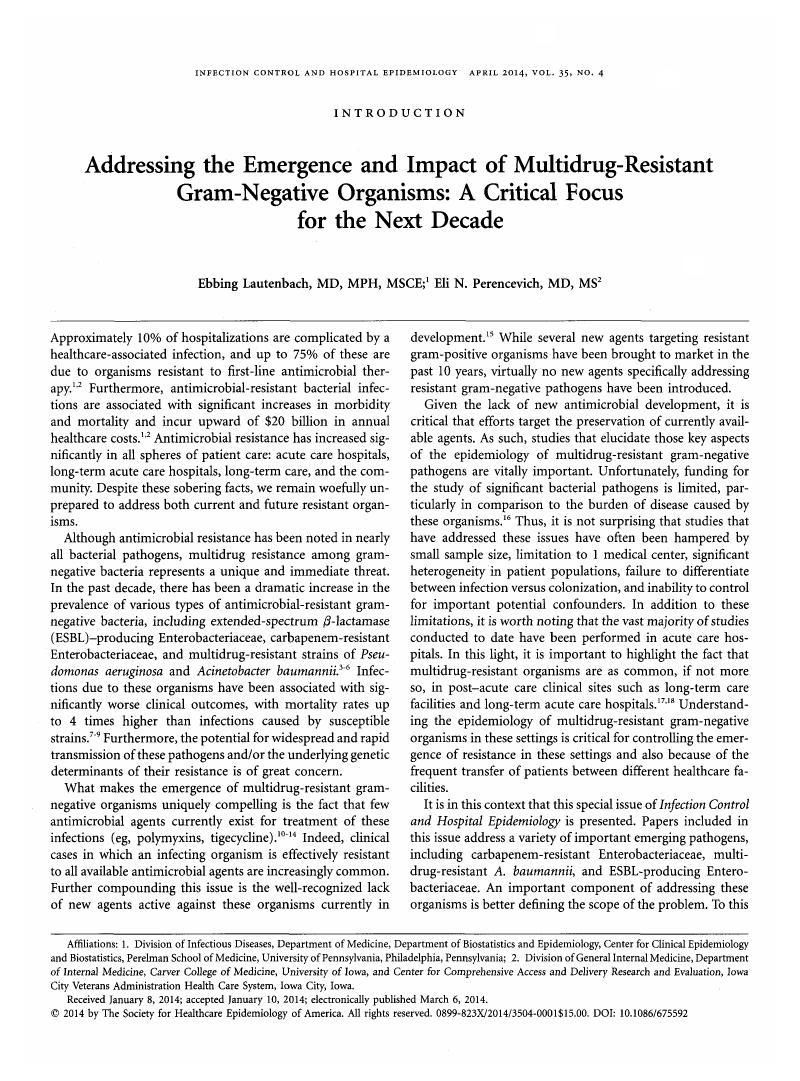Crossref Citations
This article has been cited by the following publications. This list is generated based on data provided by Crossref.
Whiteley, Greg S.
Derry, Chris
Glasbey, Trevor
and
Fahey, Paul
2015.
The Perennial Problem of Variability In Adenosine Triphosphate (ATP) Tests for Hygiene Monitoring Within Healthcare Settings.
Infection Control & Hospital Epidemiology,
Vol. 36,
Issue. 6,
p.
658.
Pogorzelska-Maziarz, Monika
Herzig, Carolyn T. A.
Larson, Elaine L.
Furuya, E. Yoko
Perencevich, Eli N.
and
Stone, Patricia W.
2015.
Implementation of Antimicrobial Stewardship Policies in U.S. Hospitals: Findings from a National Survey.
Infection Control & Hospital Epidemiology,
Vol. 36,
Issue. 3,
p.
261.
D’Agata, Erika M. C.
Habtemariam, Daniel
and
Mitchell, Susan
2015.
Multidrug-Resistant Gram-Negative Bacteria: Inter- and Intradissemination Among Nursing Homes of Residents With Advanced Dementia.
Infection Control & Hospital Epidemiology,
Vol. 36,
Issue. 8,
p.
930.
Taşova, Yeşim
2015.
Risk Factors of Carbapenem-Resistant Klebsiella pneumoniae Infection: A Serious Threat in ICUs.
Medical Science Monitor,
Vol. 21,
Issue. ,
p.
219.
Oliveira, Viviane Decicera Colombo
Rubio, Fernando Góngora
Almeida, Margarete Teresa Gottardo
Nogueira, Mara Corrêa Lelles
and
Pignatari, Antonio Carlos Campos
2015.
Trends of 9,416 multidrug-resistant Gram-negative bacteria.
Revista da Associação Médica Brasileira,
Vol. 61,
Issue. 3,
p.
244.
Raman, Gowri
Avendano, Esther
Berger, Samantha
and
Menon, Vandana
2015.
Appropriate initial antibiotic therapy in hospitalized patients with gram-negative infections: systematic review and meta-analysis.
BMC Infectious Diseases,
Vol. 15,
Issue. 1,
Tognim, M.C.B.
and
Cardoso, C.L.
2016.
Nosocomial outbreaks in Brazil: can they be controlled?.
Journal of Hospital Infection,
Vol. 94,
Issue. 4,
p.
320.
Borgogna, Timothy R.
Borgogna, Joanna-Lynn
Mielke, Jenna A.
Brown, Celeste J.
Top, Eva M.
Botts, Ryan T.
and
Cummings, David E.
2016.
High Diversity of CTX-M Extended-Spectrum β-Lactamases in Municipal Wastewater and Urban Wetlands.
Microbial Drug Resistance,
Vol. 22,
Issue. 4,
p.
312.
Al-Dorzi, Hasan M.
and
Arabi, Yaseen M.
2017.
Outbreaks in the adult ICUs.
Current Opinion in Infectious Diseases,
Vol. 30,
Issue. 4,
p.
432.
Candevir Ulu, Aslıhan
Güven Gökmen, Tülin
Kibar, Filiz
Kurtaran, Behice
Önlen, Cansu
Kuşçu, Ferit
İnal, Ayşe Seza
Kömür, Süheyla
Yaman, Akgün
Aksu, Hasan Salih Zeki
and
Taşova, Yeşim
2017.
Molecular epidemiology of carbapenem-resistant Klebsiella pneumoniae at a Turkish centre: Is the increase of resistance a threat for Europe?.
Journal of Global Antimicrobial Resistance,
Vol. 11,
Issue. ,
p.
10.
Wu, Chang-Teng
Chen, Chyi-Liang
Lee, Hao-Yuan
Chang, Chee-Jen
Liu, Pi-Yu
Li, Chin-Ying
Liu, Ming-Ying
and
Liu, Chien-Hsisung
2017.
Decreased antimicrobial resistance and defined daily doses after implementation of a clinical culture-guided antimicrobial stewardship program in a local hospital.
Journal of Microbiology, Immunology and Infection,
Vol. 50,
Issue. 6,
p.
846.
Chaves, Thiago P.
Pinheiro, Raizza Eveline E.
Melo, Eveny S.
Soares, Maria José dos S.
Souza, João Sammy N.
Andrade, Tiago Brito de
Lemos, Telma Leda Gomes de
and
Coutinho, Henrique D.M.
2018.
Essential oil of Eucalyptus camaldulensis Dehn potentiates β-lactam activity against Staphylococcus aureus and Escherichia coli resistant strains.
Industrial Crops and Products,
Vol. 112,
Issue. ,
p.
70.
Riedel, Stefan
Boire, Nicholas
Carson, Kathryn A.
Vadlamudi, Aravinda
Khuvis, Joshua
Vadlamudi, Vivek
Atukorale, Vajini
Riedel, Victoria A. A.
and
Parrish, Nicole M.
2019.
A survey of antimicrobial resistance in Enterobacteriaceae isolated from the Chesapeake Bay and adjacent upper tributaries.
MicrobiologyOpen,
Vol. 8,
Issue. 9,
Silva, Romerio R.S.
Silva, Carolina R.
Santos, Valdenice F.
Barbosa, Cristina R.S.
Muniz, Debora F.
Santos, Ana L.E.
Santos, Maria H.C.
Rocha, Bruno A.M.
Batista, Karla L.R.
Costa-Júnior, Livio M.
Coutinho, Henrique D.M.
and
Teixeira, Claudener S.
2019.
Parkia platycephala lectin enhances the antibiotic activity against multi-resistant bacterial strains and inhibits the development of Haemonchus contortus.
Microbial Pathogenesis,
Vol. 135,
Issue. ,
p.
103629.
Li, Yuanyuan
Li, Jihong
Hu, Tong
Hu, Jia
Song, Ning
Zhang, Yu
and
Chen, Yuan
2020.
Five-year change of prevalence and risk factors for infection and mortality of carbapenem-resistant Klebsiella pneumoniae bloodstream infection in a tertiary hospital in North China.
Antimicrobial Resistance & Infection Control,
Vol. 9,
Issue. 1,
D’Atanasio, Noemi
Capezzone de Joannon, Alessandra
Di Sante, Laura
Mangano, Giorgina
Ombrato, Rosella
Vitiello, Marco
Bartella, Cristina
Magarò, Gabriele
Prati, Federica
Milanese, Claudio
Vignaroli, Carla
Di Giorgio, Francesco Paolo
Tongiani, Serena
and
Narayanasamy, Prabagaran
2020.
Antibacterial activity of novel dual bacterial DNA type II topoisomerase inhibitors.
PLOS ONE,
Vol. 15,
Issue. 2,
p.
e0228509.
Flannery, Dustin D.
Chiotos, Kathleen
Gerber, Jeffrey S.
and
Puopolo, Karen M.
2022.
Neonatal multidrug-resistant gram-negative infection: epidemiology, mechanisms of resistance, and management.
Pediatric Research,
Vol. 91,
Issue. 2,
p.
380.
Monari, Caterina
Spagnuolo, Ferdinando
Pisaturo, Mariantonietta
Ascione, Serena
Donnarumma, Giovanna
Calò, Federica
Caredda, Elisabetta
Montella, Fortunato
Maietta, Anna
Montaldo, Paolo
Pugliese, Umberto
Galdiero, Massimiliano
Carpentieri, Mauro
and
Coppola, Nicola
2023.
Bloodstream Infection Due to a VIM-Metallo-β-Lactamase-Producing Klebsiella pneumoniae Treated with Cefiderocol in a Preterm Newborn.
Infectious Diseases and Therapy,
Vol. 12,
Issue. 2,
p.
727.
Abuhammad, Sawsan
Alwedyan, Dalya
Hamaideh, Shaher
and
AL-Jabri, Mohammed
2024.
Knowledge, Attitude, and Practices of Mothers Working as Nurses Toward Multidrug-Resistant: Impact of an Educational Program in Neonatal Intensive Care Unit.
Infection and Drug Resistance,
Vol. Volume 17,
Issue. ,
p.
1937.
Wang, Ling
Zeng, Chaoying
Li, Xue
Li, Yuqing
Liu, Zhihua
and
Hu, Jing
2024.
Mortality associated with carbapenem resistance in Klebsiella pneumoniae bloodstream infection: A propensity score–matched study.
Infection Control & Hospital Epidemiology,
Vol. 45,
Issue. 7,
p.
839.



